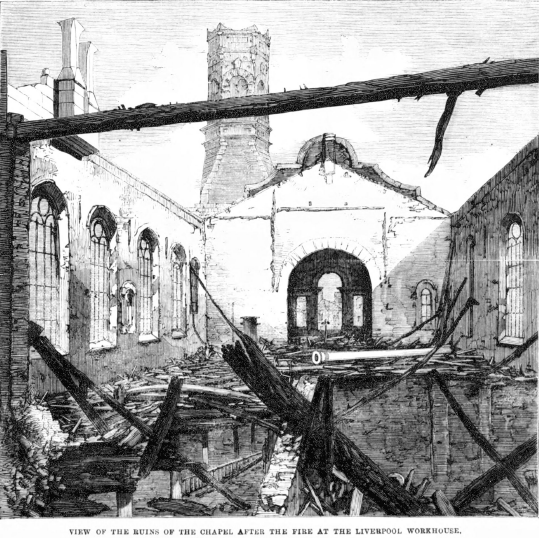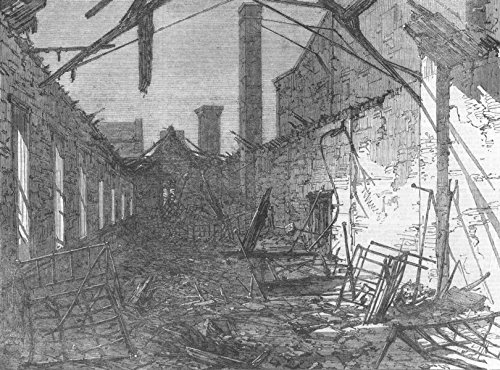WORKHOUSE FIRE 1862

Remains of the chapel of the Liverpool Workhouse
Illustrated news Sept 1862
Liverpool Albion, 8th September, 1862

Remains of the chapel of the Liverpool Workhouse
Illustrated news Sept 1862
Liverpool Albion, 8th September, 1862

Remains of the children's dormitory, the Graphic Sept 1862
10th September 1865 Inquest was resumed by Mr DRIFFIELD, Mr CURWOOD, Deputy town clerk, appeared to watch the case on behalf of the corporation, and Mr BREMNER, solicitor on behalf of the parish authorities. Mr CARR the governor of the workhouse was again examined, he spoke as above other than to add that at the time of the fire there was a pile of clothes lying in the infants schoolroom, not far from the passage leading to the dormatories and in the schoolroom was a cupboard full of books and bonnets and a wooden gallery where the children sat, when he first noticed the fire it appeared to be coming from the direction of the cupboard and the pile of clothes. Miss KENNAN schoolmistress, was examined, she slept near the childrens dormitory and was awakened by a strong smell of smoke in her room. She told some of the children to run through the establishment and shout “Fire!” From the first she thought the fire serious and informed the governor As she crossed the iron grid covering the passage between the church and the dormitory she felt it was warm, and when she returned from the house of the governor the heat had greatly increased, and dense smoke was rising up it. On going upstairs she heard cries, but was unable to advance into the room in consequence of the density of the smoke. Creeping on her hands and knees in the room and feeling the foot of a child she took hold of the child and succeeded in recuing the child Jane MITCHELL. In endeavouring to go into the room again to some one who called her she became insensible and knew nothing more of what had occurred until she found herself lying at the front door below. Witness corroborated Mr CARR as to there being on the school room floor a quantity of clothing and some bonnets and shawls etc, in the cupboard The articles were there the previous afternoon at 4.30pm, when witness was in the room. Candles and matches were not allowed to the inmates. Maurice POWER superintendent of the parochial vagrant sheds, spoke chiefly as to the position in which 11 of the children were discovered, stating they appear to have been suffocated and then scorched by fire, and they lay as though they were asleep. A police officer named BUSHBY was next examined as to the steps taken on the discovery of the fire, his evidence however was not material. Major GREIG head constable of Liverpool who was next examined, said that when he arrived at the scene of the fire about 3am, he found the supply of water from the hydrants was very weak, and in consequence of the low pressure [the building is situated on very high ground [the water could not be thrown direct from the hose as high as the windows of the dormitory. Mr J. HEWITT, superintendent of the Liverpool Fire Brigade, corroborated this evidence. The Coroner summed up the evidence after which the jury returned a verdict that the children were accidentally suffocated, and made a further presentment that there was insufficient pressure on the water supply. Liverpool Mercury, 13th September, 1862 The fatal fire at Liverpool workhouse A poor, simple hearted woman named Harriet MEACOCK, got safely out herself, but went backwards and forwards many times, bringing out little terrified and almost lifeless children, and at length she herself became suffocated with the smoke. She was got out, but died almost immediately afterwards., Tuesday, September 16, 1862.jpg)